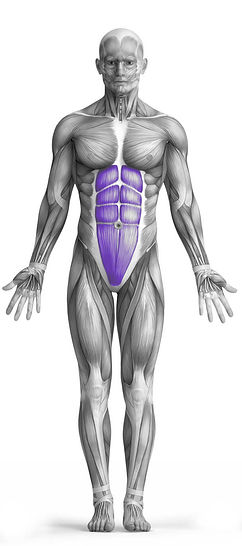Pallof Press With Rotation 101 Video Tutorial
0

Timer
Hour
Minute
Second
Stopwatch
00:00:00:00
Overview
The Pallof Press With Rotation is a dynamic exercise that primarily targets the abdominal muscles with secondary engagement of the serratus and lat muscles. Utilizing a cable machine, this exercise involves standing perpendicular to the machine with the cable attachment positioned at chest height. The individual extends their arms in front of their body, pressing the cable away from the torso while resisting rotational forces. The rotation component of the movement challenges the core muscles further, promoting stability and strength. By maintaining a stable core and resisting rotation, the Pallof Press With Rotation effectively strengthens the abs while also engaging the serratus and lats.
How to Perform
Begin by standing upright and attaching a handle to a cable stack positioned at chest height, ensuring it is securely fastened.
Hold the handle close to your chest and establish an athletic base position with your feet slightly wider than shoulder-width apart to maintain stability throughout the exercise.
Initiate the movement by pressing the handle horizontally away from your chest, fully extending your arms while maintaining tension in the abdominal muscles.
As you press the handle, simultaneously rotate your torso away from the cable stack, engaging the obliques and serratus muscles to resist rotational forces.
Hold the extended position briefly, focusing on maintaining stability and control.
Slowly return to the starting position, bringing the handle back towards your chest while keeping the core engaged.
Repeat the movement for the desired number of repetitions on both sides, ensuring equal engagement of the obliques and maintaining proper form throughout.
Throughout the exercise, emphasize smooth and controlled movements, avoiding any jerky or uncontrolled motions that may compromise form or effectiveness.
Remember to breathe steadily and maintain core activation throughout the entire range of motion to maximize the benefits of the exercise.
Adjust the weight resistance on the cable machine as needed to challenge your muscles effectively without sacrificing proper form.
★ Bonus: For exercises that involve external weights (such as dumbbells, barbells, or machines), the One Rep Max (1RM) calculator can help you estimate your maximum lifting capacity. Use it to track your strength progress and adjust your training for optimal results.
Tips
To maintain proper form and maximize effectiveness, ensure that your hips remain stable and do not rotate as you extend the handle during the Pallof Press With Rotation exercise.
Exhale as you press the handle away from your body to enhance abdominal activation, utilizing your breath to drive the movement and engage the core muscles more effectively.
Focus on generating rotation through the shoulders and thoracic spine rather than the lumbar spine to minimize the risk of discomfort or strain in the lower back area. If you experience any pain or pressure in the lumbar spine, reassess your rotational stability and consider regressing to a simpler variation of the exercise.
If maintaining a neutral spinal position is challenging, consider regressing to a supine variation of the exercise before progressing to half kneeling and tall kneeling variations to improve lumbo-pelvic control gradually.
Avoid holding your breath during the exercise, as relying on respiration to compensate for instability can compromise form and effectiveness. Instead, focus on moving while maintaining proper position and stability without the need for breath-holding.
How Not to Perform
Avoid Overarching the Lower Back: Do not hyperextend the lower back as you press the handle away from your body, as this can strain the lumbar spine and detract from the engagement of the abdominal muscles.
Do Not Rotate the Hips: Ensure that your hips remain stable and do not rotate throughout the movement. Rotating the hips can reduce the effectiveness of the exercise and increase the risk of injury to the lower back.
Avoid Using Excessive Weight: Do not select a weight that is too heavy, as it can lead to compromised form and increased strain on the shoulder and back muscles.
Do Not Rely on Momentum: Avoid using momentum to complete the movement. Instead, focus on controlled, deliberate movements to maximize muscle activation and effectiveness.
Avoid Shrugging the Shoulders: Keep your shoulders relaxed and avoid shrugging them towards your ears during the exercise. This ensures that the tension remains on the abdominal muscles rather than the shoulders.
Do Not Hold Your Breath: Avoid holding your breath during the exercise. Remember to breathe steadily and rhythmically throughout each repetition to maintain oxygen flow to the muscles and enhance performance.
Do Not Overextend the Arms: Avoid fully extending the arms at the bottom of the movement, as this can strain the shoulder joints and detract from the engagement of the abdominal muscles.
Do Not Neglect Core Stability: Ensure that you engage your core muscles throughout the entire movement to stabilize your spine and prevent excessive movement in the lower back.
Avoid Twisting Too Far: Do not twist your torso too far during the rotation phase of the exercise. Twisting too far can increase the risk of injury and reduce the effectiveness of the exercise.
Do Not Rush Through Repetitions: Avoid rushing through the repetitions. Focus on performing each repetition with proper form and technique, emphasizing the contraction of the abdominal muscles throughout the entire range of motion.
Variations
Variations of fitness exercises refer to different ways of performing a specific exercise or movement to target various muscle groups, intensities, or goals. These variations aim to challenge the body differently, prevent plateaus, and cater to individuals with varying fitness levels.
Alternatives
Alternative exercises in fitness refer to different movements or activities that target similar muscle groups or serve the same training purpose as the primary exercise. These alternative exercises can be used as substitutes when the original exercise is unavailable or challenging to perform due to various reasons such as equipment limitations, injuries, or personal preferences.








